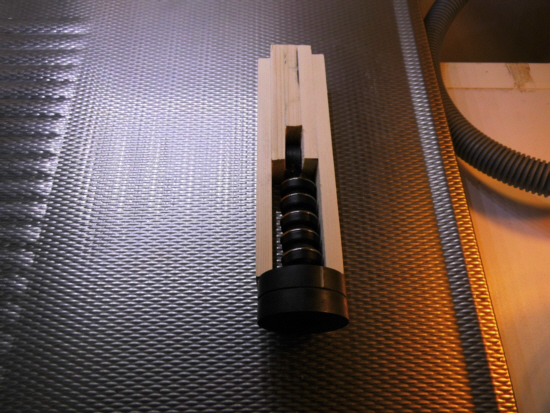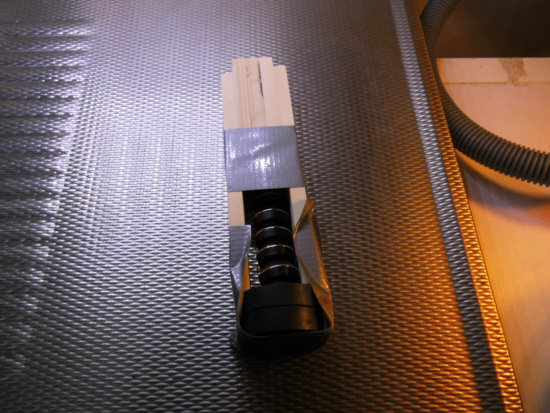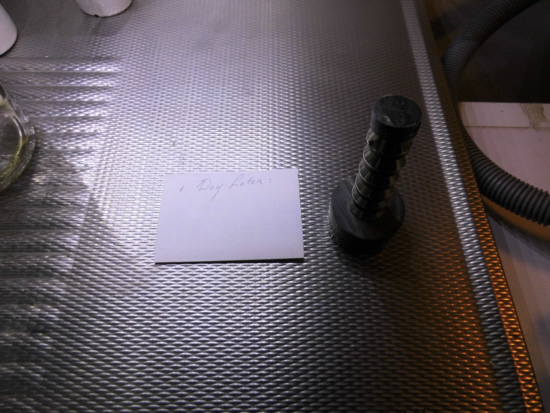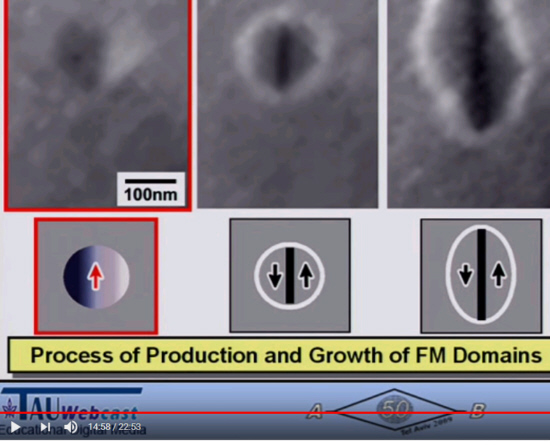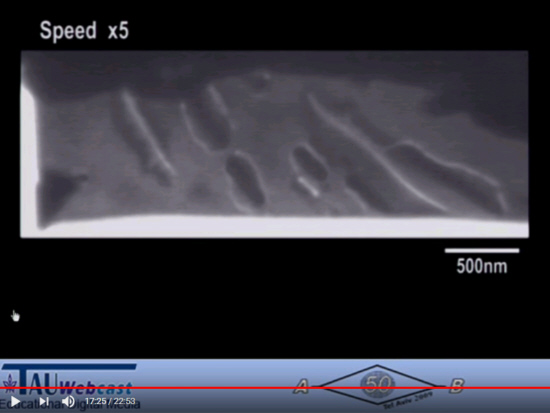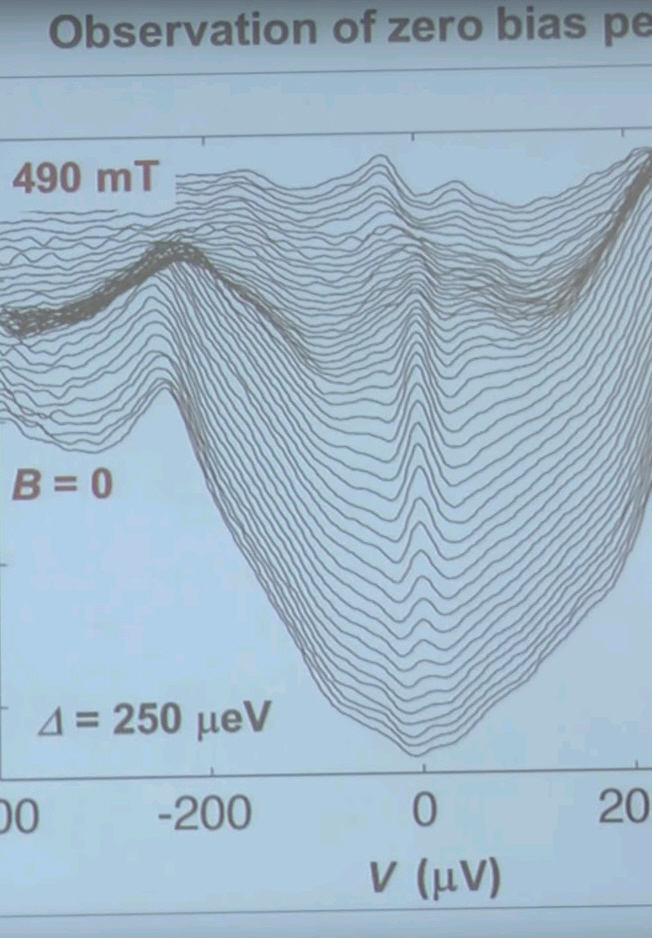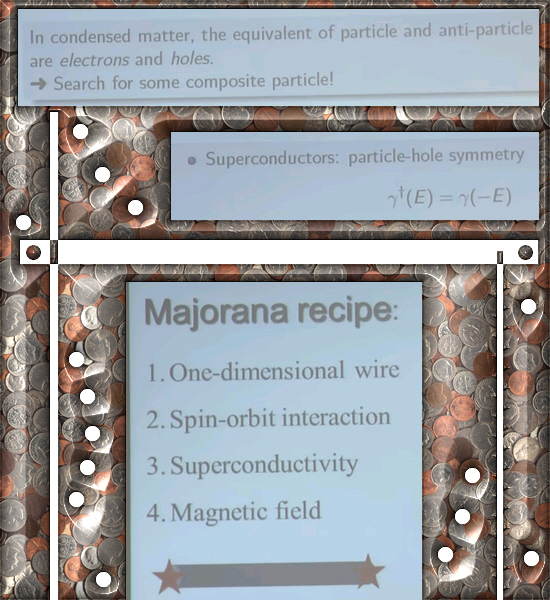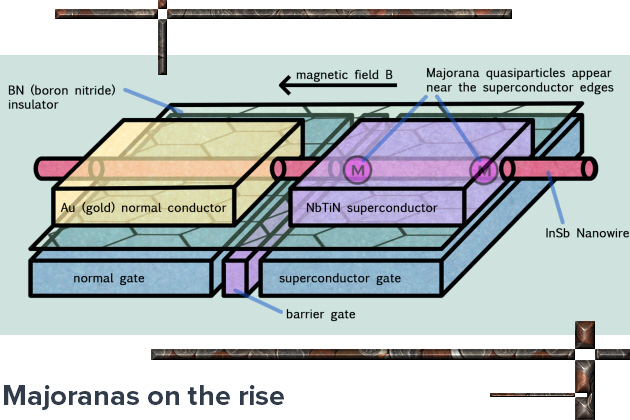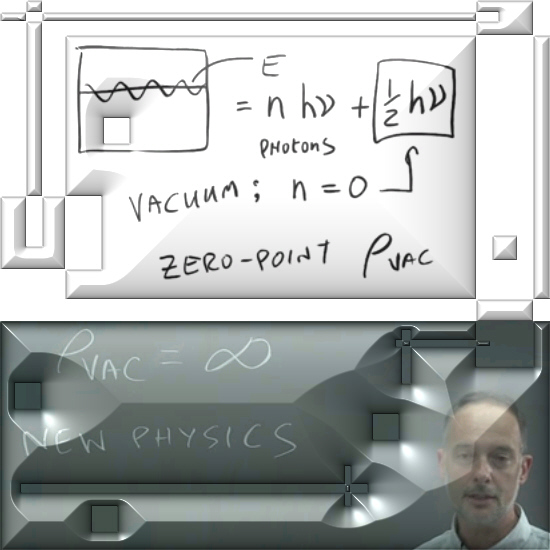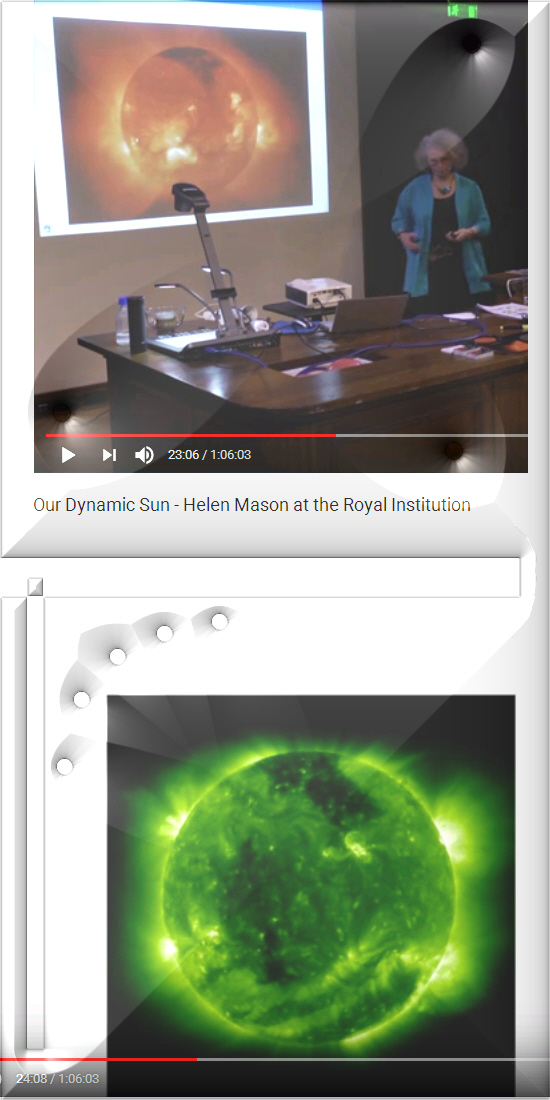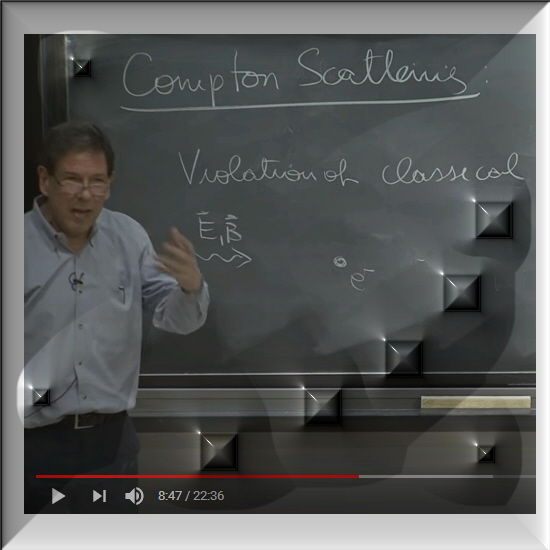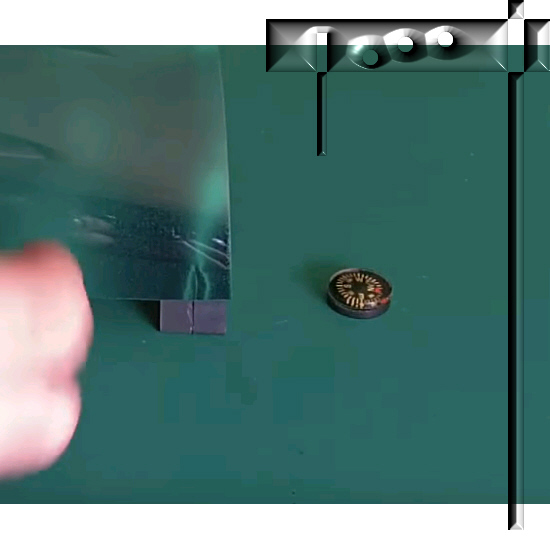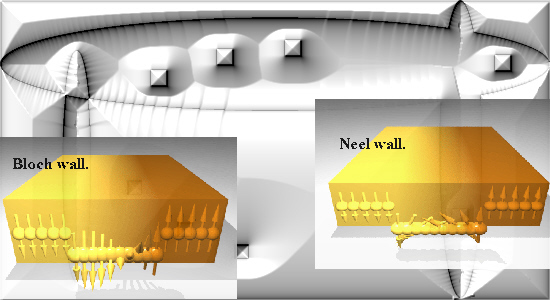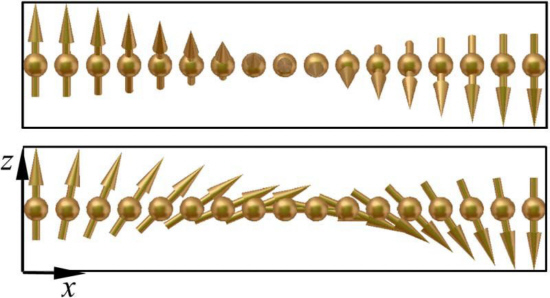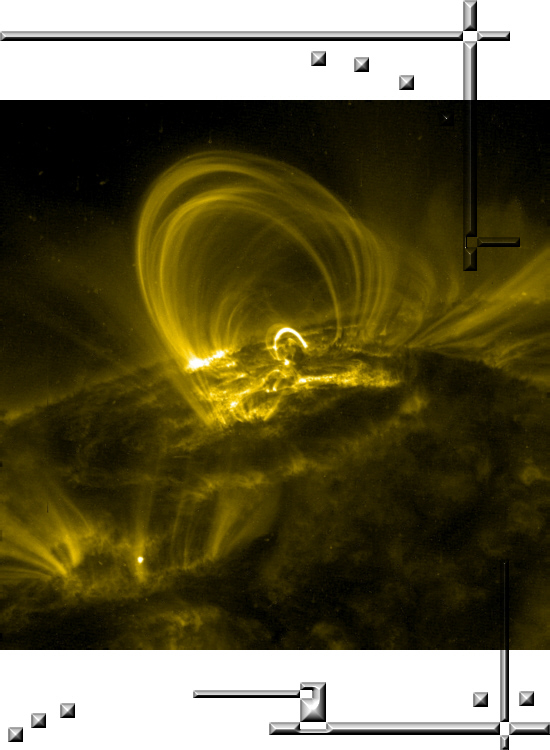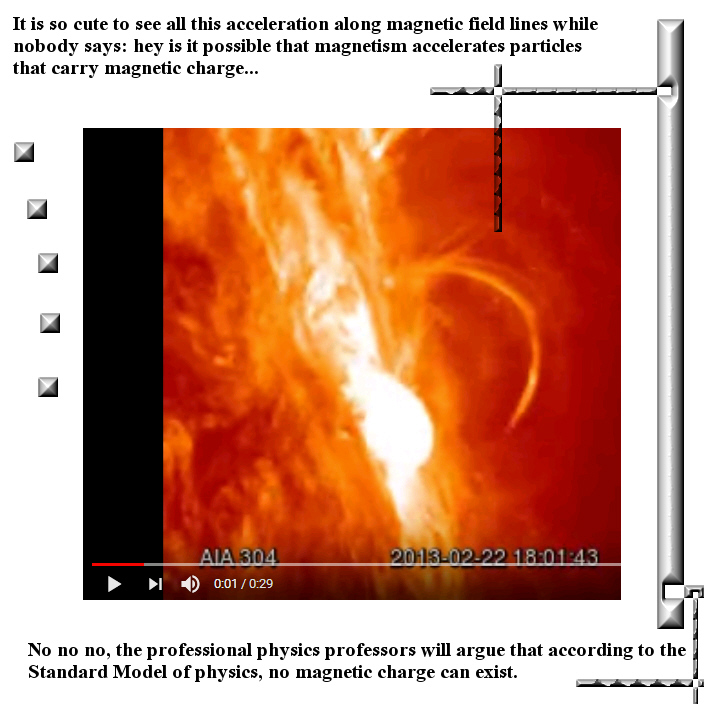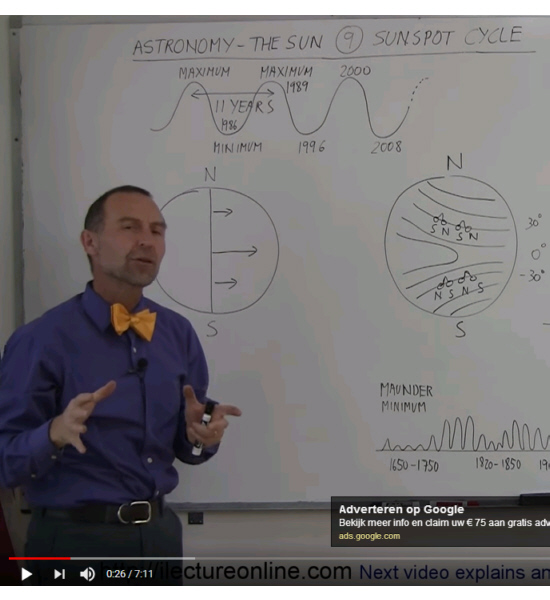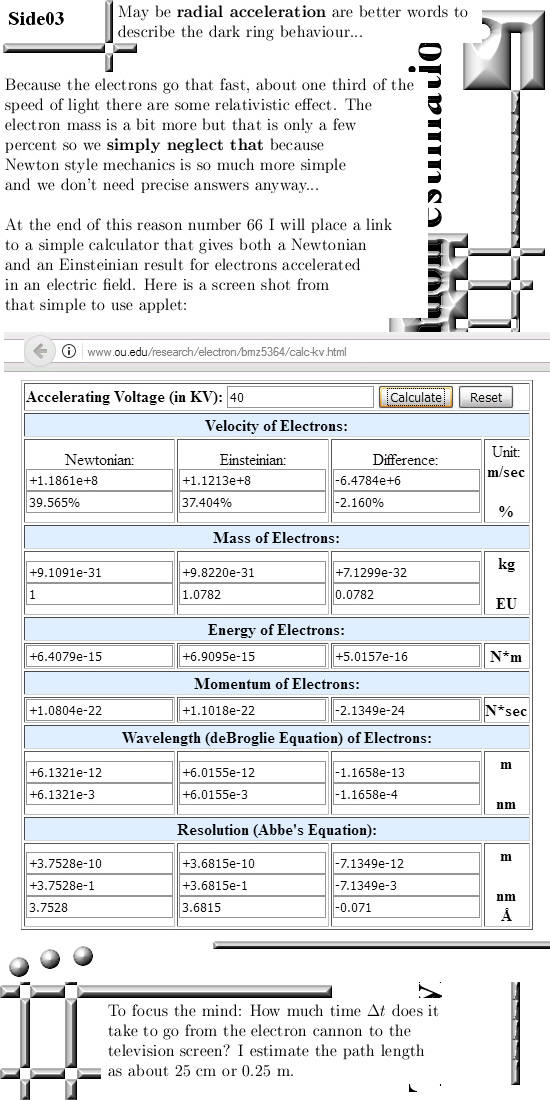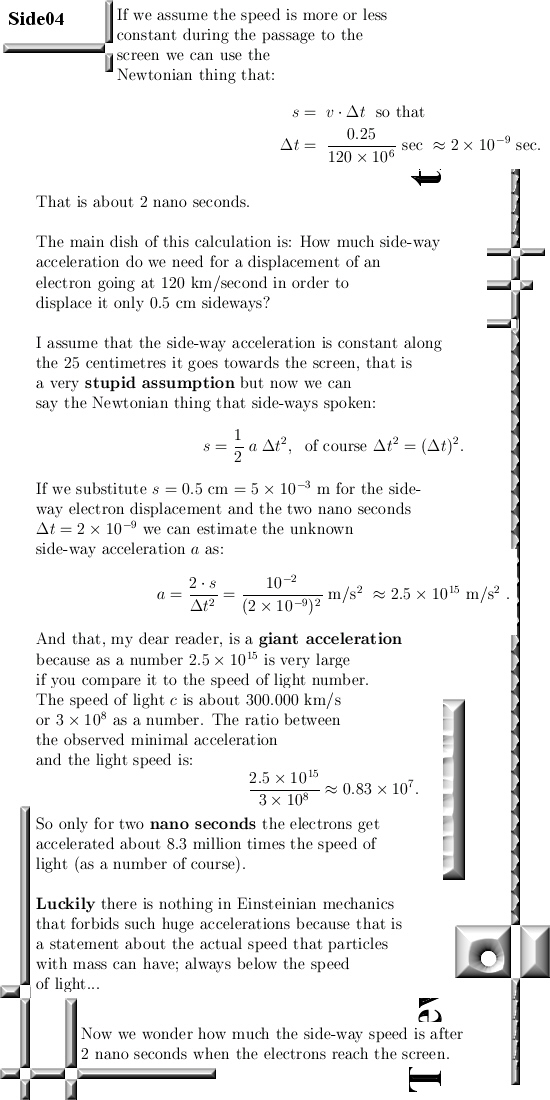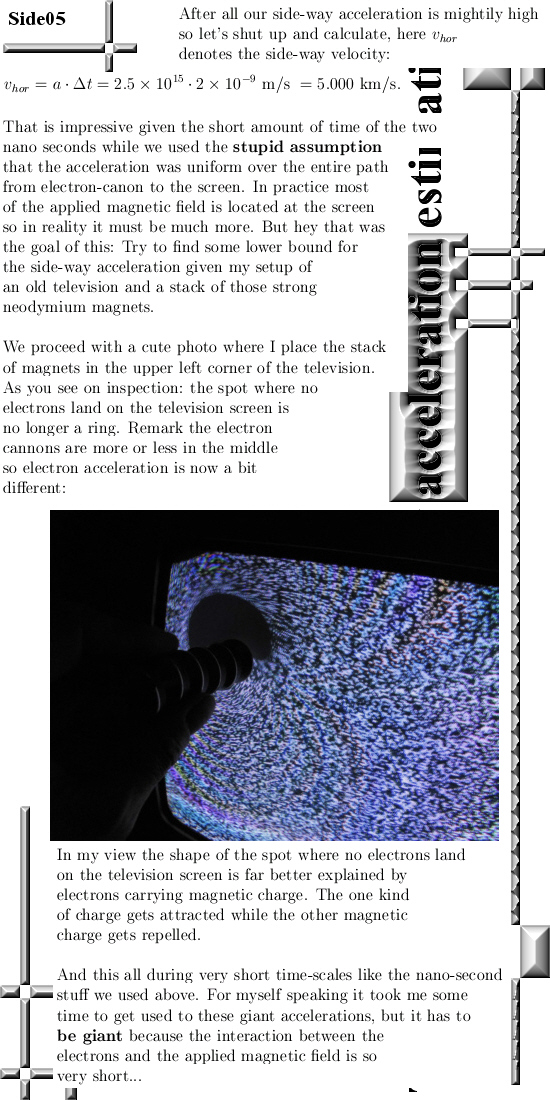| Page 3 of the magnetic pages covering the stuff found in the year 2018. | |
|
|
|
| Introduction: In
this html page on magnetism we will focus on a weird detail of the so
called Stern-Gerlach experiment from the year 1922 where they managed to
separate a stream of silver ions into two parts. And the culprit was one loose unpaired electron that did split this stream of silver ions. I was 50 years of age when I
read these weird results for the first time and I did not understand
them: Within two days I had the answer: Electrons are magnetic monopoles because only monopoles can be repelled by the stronger side of a magnetic field. I was very surprised by my own result because I too was indoctrinated by 'Magnetic monopoles do no exist' kind of thinking. Anyway, two years back that was the starting point of the 'electrons are magnetic monopoles'. Have fun reading it and
hopefully you will learn something from it.
|
|
|
|
|
|
08 Feb 2018: Reason 53:
Domain walls of magnetic domains explained (electron pairs).
Of course I still follow the evolution of IBM's racetrack memory because I still think it will fail if the IBM employees refuse year in year out to prove that an electron is actually a magnetic dipole. Electrons do not have a magnetic dipole moment because they carry one of the two possible magnetic charges; either the magnetic north charge of the magnetic south charge. It was about four years back when I found that out and on this day it is once more IBM's Stuart Parkin telling me that the domain walls of the nano wires he uses can not be moved by magnetic fields... Those domain walls can only be moved by electrical currents. Have you never heard about that racetrack memory
concept from IBM? Stuart Parkin - Spin Orbitronics for Advanced Magnetic Memories (QM90) At about 15 minutes into the video Stuart tells us three important things: Thing 1) Domain walls act like particles with momentum. Thing 2) Electrical current drives the domain wall (in the nano wires of course). And, most important; Thing 3) It is impossible to move the domain walls of the magnetic domains with magnetic fields. Because I think electrons are not magnetic dipoles but only have one of two possible magnetic charges, from that point of view only the electron pair is magnetically neutral. All unpaired electrons, under application of a magnetic field, will either feel an attractive force or a repelling force into the direction of the applied magnetic field. And if you view electrons as having a magnetic charge,
suddenly you do not understand a metal like iron. All in all those domain walls must be mostly made up from electron pairs. It is easy to understand why: the magnetic domains have
a surplus of either north or south magnetic charges. Before I close this update I think it is important to
once more make the point of experimental validation. After having said that (I do not fear the experiment because I am not like those string theory weirdo's), let me close this post with what I consider stupid crap you get if you view electrons as being magnetic dipoles. For example Stuart Parkin is thinking that inside the domain walls the electrons have their magnetic vector pointing perpendicular to most magnetic vectors as residing inside those very magnetic domains... It is nonsense but it not only sticks into the heads of folks like Stuart but also the head of your average physics professor... Ok, let's leave it with that. Till updates.
|
|
|
22 Feb 2018:
Reason 54: Spin Hall effect in circular conductors or back to the basics?
One of the oldest known break through experimental results is the fact that around a conducting wire like a copper wire, a circular magnetic field is measured that goes around the electricity transporting wire. You might say, ok that is fine but because this is an old result it is deeply invested in present day physical understanding of how electrons move through the conducting wires... So if my insights upon electrons are correct and they carry only one of two possible magnetic charges, as such if they feel a magnetic field they get accelerated by this, how would the electrons react to the circular magnetic field around the wire that they create themselves? Very simple: We know electricity streams mostly on the outside of a conductor, since the finding of the circular magnetic field is way back in history it must be a relative strong effect. Therefore in a reaction to that circular magnetic field around the wire perpendicular of the average electron drift direction, the electrons will be pushed into helical orbits around the conducting wire in the direction of the average electron drift. As such in all copper wires around the world, my (magnetic) north pole electrons will follow another helical path compared to the electrons that carry the south magnetic charge. In the meantime, if electrons pairs contribute to the transport of electricity in the wire, they are magnetically neutral so they could follow any path they like. Let's keep it as simple as it
is: Historically speaking this is an old experimental finding so it must
be relatively strong. As you see I never talked about all kids of Hall effect like 'intrinsic spin coupled to orbital spin while we are injecting all this spin angular momentum'... Come on, I only talk about the things I understand and furthermore you could try to do some experiments that validate this view on electron stream, or drift, inside ordinary conductors like copper wire... So as far as I am concerned, why not go back to the basics? End of this update. See you around. Updated one day later: I tried to find some pictures on our beloved internet about the stream of electrons on the surface of electricity conducting wires. In the preprint archive I found a cute picture that at best paints half of the picture. Let me spare you the details but if in broad daylight we would always have equal amounts of spin up and spin down stuff on the surface of conductors, antenna's would not work properly. (Antennas are driven by electricity and as such they need antennas with a strong surplus in either spin direction). Here is the screenshot: Preprint archive
source: Spin
Hall effect Let me close this reason number 54 because the best way of convincing yourselves that electrons cannot be magnetic dipoles is found inside your own head. Just start thinking about an electron as having only one electric charge but two possible magnetic charges and could that too explain all those electric and magnetic stuff we observe? So look inside your own brain and not in mine... End of reason number 54.
|
|
| 07March2018:
Reason 55: The way a simple nano spin valve works.
From a video from Nanohub dot org I selected at about
7 minutes into the video the strange ways that a simple spin valve should
work. It is only 'strange' when you think of electrons as being magnetic
dipoles, if you use the idea that electrons carry magnetic charge all of a
sudden the inner workings of the spin valve are totally obvious: Title of the video: nanoHUB-U Fundamentals of Nanoelectronics II: M4.1 Spin Transistor - One-Level Spin Valve Here you see Supriyo Datta, a good teacher by the way, at about seven minutes into the video pointing what kind of electrons come more easy out of the spin valve: A spin valve works pretty simple: In the picture above the [H] is some conducting material and the two rectangular contacts are magnetic such that the magnetic field is aligned with the electrical current. If you view electrons as magnetic dipoles this is highly confusing because after all according to the official theory in permanent magnets all spins are aligned and that alignment creates the overall macroscopic magnetic field. And here Supriyo Datta is telling us that the dipole electrons who should feel at home in that magnetic field and would like top contribute of the overall magnetic field are the ones that pass in a much greater ratio compared to the electron spins that are not aligned... But if you view electrons as carriers of magnetic charge and lets say the electrons in the current leave the magnet at the north pole, it is extremely simple to understand as why the electrons with the north charge are repelled: like (magnetic) charges repel... So far for the spin valve, we looked at ideas like this before when we discussed how the giant magneto resistance works. The GMR effect can also easily be explained by electrons having a magnetic charge beside the electrical charge. This was reason number 55: The easy to understand spin valve selects electrons going through because like magnetic charges repel just as we have with electrical charges... Till updates.
|
|
| 08
March 2018: Reason 56: This experiment shows zero spin torque transfer.
This experiment is very simple: With a stack of my strongest (permanent) magnets we are going to try to create so called spin transfer into my weakest permanent magnet. I am well aware that professional physics professors will never ever post photo's of just some pieces of wood and a few magnets in them; the perfumed princes are just soooo important that they just don't do stuff like that. Bah, checking if in practice all those fancy theory stuff works is just not for them... It is regrettable that I cannot find back the video that made me decide to finally do this very simple experiment, but the video was relatively annoying because every time an electron entered a magnetic field the speaker told again and again that the electron will resonate because it's spin will almost never be perfectly aligned with the magnetic field... Furthermore this person stated again and again that permanent magnets were nothing but the sum of their spins and that those electrons without perfect alignment with the overall macroscopic magnetic field would always have some torque. And there was constantly talk of so called spin torque transfer. Of course the speaker in the video was constantly thinking that after some torque stuff the electron would either align or anti align with the applied magnetic field. I hefty disagree with such lines of reasoning, after my humble opinion a magnetic field cannot flip the spin state of the electron. But what about those resonance's that are observed in for example MRI imaging in hospitals or electron spin resonance? Very simple: The electrons that resonate are always attached to some atom or molecule and only those resonate. So as soon as I find an experiment where for example electrons in a plasma in the laboratory that are clearly not attached to a nucleus also start resonating, I will have to throw away my 56 reasons and start all over again... __________ I made four photo's from this simple experiment, my old compass did not work any more and it needs replacement. It is not important to know where north and south poles of the permanent magnets are but using a compass it all looks a bit more neat and of that is what I desire... On the weak magnet I wrote the letter S on the side
that is most attracted to the tip of the stack of the small magnets. The neodymium magnets on their own can lift an iron halter with a mass of five kilo. So they are strong and still fresh... I left the photo's unaltered, if you click on a small photo you get the larger version of it. The idea of this experiment is very simple: The magnetic field of the strong magnets is placed as good as can be perpendicular on the one rather weak magnet. After all if all that spin torque flipping was for real, slowly the stronger magnetic field would eat it's way in the weak magnet until all flip able electrons have their new spins aligned with the strong magnetic field. It just does not happen of course... Here are the four small photo's: Again: the letter S is not the south pole of the magnet but the side that is most strongly attracted by the tip of the stack of strong magnets. The weak magnet is so weak that also on the other side it sticks to the flat tip of the stack of strong magnets. Nest you see the easy to understand experimental set up: Again: The strong permanent magnetic field is perpendicular to the field of the weak magnet. Now we tape it in and wait for at least 24 hours. By the way, the metal it is resting on is not magnetic. With hindsight it might be better to put some wooden boards under it. After about 25 hours I removed the tape and looked for any kind of difference in macroscopic behavior. For example place the weak magnet on it's side of the tip and see what happens... I could not observe any change in the behavior of the weak magnet, it just wanted the letter S right on the flat tip just like yesterday. So not much spin flip via a magnetic field observed. One day later it looks like this (on the piece of paper it says 1 day later): __________ It was not expected that a magnetic field would flip the electron spin, just like a strong electrical field never flips the electrical charge of an electron or a proton. It just does not happen by an electric field so why should a magnetic field be able to flip the magnetic charge of an electron? As far as I understand this 'electron spin flip', always some photon stuff is involved. Pure macroscopic electrical or magnetic fields never flip charges... Useful links: Understanding how permanent magnets are made in
practice reveals a lot about the likelihood that electrons carry magnetic
charge beside their electrical charge, it is not a collection of electron
spins pointing into the same direction. How permanent magnets work, the official version against what I think of
it. Also the day to day practice of medical MRI does not observe much spin flip via the applied strong magnetic field. On the contrary, for scanning your body the strong magnetic field is only used for making your body responsive to much weaker oscillating magnetic fields and additionally some RF readout coils for processing the photons that come with all this magnetic oscillating stuff. Compare it to a guitar or a violin: You do not make much music if all strings are loose, each and every guitar and violin string must have it's own spanning tension otherwise the music will sound terrible. If strong magnetic fields would be capable of flipping the magnetic state of most of your body particles (electrons and protons and neutrons) you would fall apart relatively fast. In practice it just does not happen because when patients in a hospital undergo this strong magnetic field, only after that it is possible to make the MRI scan... No spin torque transfer observed, sorry... The next video is full of errors but you can use it as a vehicle of understanding magnetic charge: Introduction
to MRI Physics End of this reason number 56.
|
|
| 24
March 2018: Reason 57: A video containing the formation of magnetic
domains
In reason number 53 as above on this page number 3 I made the bold claim that in general the domain walls of magnetic domains contain more electron pairs while every magnetic domain had a surplus of either north pole magnetically charged electrons or a surplus of south pole charged electrons. This is a bold claim but they say good science is falsifiable and that means if it is false this can be proven experientially. Ok, why should such surpluses occur anyway? After all like charges repel for both the electrical charge and the magnetic charge of the electron. Why, at a fixed temperature and no influence of outside magnetic and electrical fields, should north pole electrons accumulate? If there is a surplus of magnetic charge, why do those electrons not go to a place with less of that particular magnetic charge? As far as I know now, this can be caused by two reasons: 1) The domain walls have a slightly higher electron
density, or That is what the stuff keeps more or less stable although it must be a highly dynamical process... The electron pairs inside the domain walls will be spinning such to counteract the magnetic fields coming from both sides, the electron pairs themselves could be forming larger structures curving around for the same goal of minimizing the incoming magnetic field. __________ Here is the Youtube video dating back to 2011: The
AB Effect and it's Expanding Applications I will show you a few screen shots but it is very important to realize that everywhere this Japanese guy draws an arrow inside a magnetic domain, it is NOT A MAGNETIC DIPOLE, but a SURPLUS OF MAGNETIC CHARGE. Ok, after having said that, at about 15 minutes into the video we have this: Some time later we observe that fresh domain walls are smooth and old domain walls are zigzag: To zigzag it off, the third screen shot shows the splitting up of a magnetic domain into two pieces: So the professional physics professors have to answer the next question: Why are domain walls so dynamical? End of this post of thinking around streams of electron pairs going round and round inside magnetic domain walls, and why are electron pairs attracted to magnetic domain walls anyway? End of this reason number 57.
|
|
| 29
March 2018 Reason 58: The main Bloch wall simply moves if you add more
magnets.
Ok, a short time ago we looked at magnetic domain walls as active, or dynamical, structures that are mostly composed of magnetically neutral electron pairs. These wall create magnetic fields that repel the electrons inside the magnetic domain and as such cause a small surplus of north pole electrons at one side of the magnetic domain wall and a small surplus of south pole electrons at the other side of the magnetic domain wall. This is a wild idea and if you believe like the professional physics professors do that the electron is not a magnetic monopole with a magnetic charge (we have never seen a magnetic monopole they say), this wild idea must be totally nonsense... Ok, let us neglect the official theory about electrons and just look at some large macroscopic object like a very standard bar magnet with a north and a south pole. If the idea of magnetic domain walls must be composed of as much electron pairs as possible (because the electron pair is magnetically neutral), where would you find the biggest domain wall in your macroscopic bar magnet? Wouldn't that be in the middle of the bar magnet where it splits the north and south pole parts of your macroscopic bar magnet? Without doubt it would, where else would it be? __________ To my surprise, because I had never heard of a thing known as a Bloch wall, it was easy to find a Youtube video on moving Bloch walls. It is a simple video but I just love that 'detector thing' that guy is using. It is much much smarter as the matrix operator the quantum physics professors use in order to measure electron spin...;) Here is the video, it is not very exiting but this is the source of the picture below: The
Bloch Wall - How the Bloch Wall can Change In the next picture you only see a few screen shots of the usage of that mysterious foil that shows the main Bloch wall: I will not discuss what I think of so called Bloch and Neel magnetic domain walls in this post. No, I would like to close this reason nr 58 with the remark that even on the macroscopic level like a bar magnet you observe all kinds of electricity going round in a permanent magnet. But it is not known if permanent magnets radiate
their magnetism away? That it for this reason, till updates.
|
|
| 07
April 2018: Reason 59: Are Majorana fermions their own anti particle?
Nope!
Back in the year 2012 it was rumored for the first time that at the Technical University of Delft they had found experimental evidence for the so called Majorana fermion. These fermions are their own anti-particle, that is a very remarkable property. In the beginning in the year 2012 it still was very vague because all observed effect could also be explained by noise but over the years using the standard model of physics it is more and more accepted that those elusive Majorana fermions are indeed found. Because a quasi particle like the Majorana fermion is it's own anti particle it cannot have any charge. Therefore an electron is combined with a hole (a hole is an electron vacancy) and as such it is considered electrically neutral. Two of such electron-hole pairs form a Majorana fermion. It has been observed that when two of those Majorana fermions meet, they annihilate and 'hence they are their own anti particle'. The goal of this update is to make it plausible that when the two parts of a Majorana fermion as described by the Delft people, the electrons will simply form an electron pair and what the two electron vacancies (the two holes) do is unknown to me. For the Delft folks, they always show you that complicated graph showing a so called 'zero bias', this means likely the nano wire has a tiny bit less resistance or a tiny bit more conductivity. Here is a screen shot: It is important to understand the applied magnetic field: It is in the direction of the semi conducting wire that is embedded in a super conductor. So if my view on electrons carrying magnetic charge is true, in that case unpaired electrons in the nano wire are either extra accelerated or de-accelerated by the applied field because of their magnetic charge... Source of the screen shots: Quantum Transport, Lecture 20: Majorana fermions
(it's about 75 minutes long) Later you will as why the zero Voltage is important; with zero voltage there is no transport of electrons that are paired up but only transport caused by the applied magnetic field for unpaired electrons in the nano wire. Here is a fast made but nice picture containing a few more screen shots from the video as mentioned above: So far for that video. Yesterday I visited https://qutech.nl/ after a long long time and the latest news was found to be: Majorana trilogy completed If you read the above it is still very fuzzy about how this all works, but then I found this where the direction of the applied magnetic field is shown in the very first picture: Majoranas
on the rise This first picture is very important because if the
applied voltage is zero the electron pairs will have no transport from
either the applied voltage or the magnetic field. Only the unpaired
electrons move because of the magnetic field. So putting it all together: At zero voltage applied to the nano wire all
transport of electrons driven by electrical fields simply stops. At the end of this update we wonder what happens if the two building blocks of the Majorana quasi particle meet? In my view they will form an electron pair because
most likely is that the two electrons have opposite magnetic charges. Before we close this update I would like to make a correction: On 08 Jan this year I wrote for the first time on the possible existence of Majorana fermions, at that point in time I was unaware of the fact there is a magnetic field applied in the direction of the nano wire and as such I assumed it was simply not included that the magnetic charges had to be opposite too in order to make it a 'neutral quasi particle. With the above picture in our minds we see that indeed such a configuration of two electrons and two holes can be both electric and magnetic neutral. Here is the link to the 08 Jan post: More on the Majorana
equation. Yet the anti particle nature of this configuration is not very convincing in my view, just like a configuration of two neutrons with opposite spin (magnetic charges) are not their own anti-particle because nothing violent happens when you bring two of those together... End of this update & see you around my dear reader.
|
|
| 09
April 2018: Reason 60: The existence of zero field splitting.
In the beginning when I started researching the stuff that was going around with electron spin all those people constantly talked about spin up or spin down. Sometimes it was spin left versus spin right must mostly it was up and down. I wasn't until I learned from Leonard Susskind that you always must view that against some applied magnetic field, that brought some clarity. Of course Leonard did not explain as why an electron would anti align against that applied magnetic field, how can it be that in the entire history of humanity we used a compass to navigate the seas while a tiny electron would position itself against the applied magnetic field... That never made any sense at all, in my view if
electrons were tiny magnetic dipoles they would all behave the same and in
the absence of other magnetic forces they all should turn such that they
are aligned with the applied magnetic field. And I agree that if you always implicit use some applied magnetic field, in that case it makes sense of talking about up or down electron magnetic spin. But even in the absence of an applied magnetic field, the up & down nature of electrons keeps on going even when there is no overall magnetic field. In the noble science of chemistry this is known as a degeneracy. With a degeneracy they mean that electrons with opposite spin are in the same energy state, as soon as there is some applied magnetic field the two energy states disappear and that is considered to be non-degenerate. This degenerate stuff is a bit more subtle because the nucleus of an atom can also have 'magnetic spin' but that is much much weaker and gives rise to stuff like hyperfine spectra when measuring energy states of electrons in an atom. Anyway, the spin of electrons does not go away in the
absence of a magnetic field. Zero
field splitting Let me quote the first words of that wiki: Zero field splitting describes various interactions of the energy levels of a molecule or ion resulting from the presence of more than one unpaired electron. The unpaired electrons mutually interact to give rise to two or more energy states. It is well known that degeneracy is lifted in the presence of a magnetic field, but zero field splitting occurs even in the absence of a magnetic field. Comment: If you think about electron and nucleus spin as vectors, this all is terribly hard to understand. But if magnetism is a charge, so there is no vector stuff at all going on, the observed phenomenon's are far more logical. After all in the absence of an electric field all of a sudden the electrons and protons never loose their electrical charge... The same goes for magnetism, if electrons also carry magnetic charge in only two possible varieties, the application of an outside magnetic field and it's direction are completely irrelevant. Let's close this update with a simple screen shot from the wiki: From the use of S_z in the above picture you can retrieve that this Hamiltonian is related to a vertical applied magnetic field. End of reason number 60.
|
|
| 26
April 2018: Reason 61: The vacuum catastrophe part 3.
This update is a prolongation from Reason 38 from 10 Oct 2016 where I state they likely use the experimental results from the Casimir effect in order to estimate in a 'theoretical manner' the energy density of space vacuum. Once more we take a look at the energy as found in a pure vacuum, the theoretical predictions for that are only something like 10^120 wrong; that is about 120 orders of magnitude beside the experimental value. I never posted much update on that; is it true
professional physics people use only the Casimir effect? In my view, the original experiments on the Casimir effect do not take into account that electron movement in metals is a highly dynamical process and although the metal Casimir plates as used in such experiments are electrical neutral, the magnetic forces are not. The electrons in the two metal sheets will reconfigure to the extent that a slight attractive force is there that spoils all measurements of the so called vacuum energy... In the next video you can find a bit of 'human evidence' that indeed the Casimir effect is used, the video is funny to see: The
vacuum catastrophe. At 3.15 minutes the funny guy says 'It was verified in a laboratory', it is very funny to see (and hear): But on vacuum energy there are much more wise people explaining their stuff. Like for example the Edinburgh university, at the end of the video they still make the same mistake as late 19-th century physics professors with their black body radiation problems. If you allow crazy high energy photons to pop up for no reason at all, you are only left with problems... 7.3a. HIGGS - Quantum Vacuum and Cosmology. Oh oh, a theory that does this is very funny.
Oh oh, this reason number 61 is just so bad because it does not make people thinking about the impossibility of electrons being magnetic dipoles... May be it shows also a bit of the vacuum of the human brain, it still has it's troubles digesting elementary math. End of this update.
|
|
| 13
May 2018: Reason 62: The 'holes' in the solar corona.
A perfect and accessible video was found about solar dynamics. The main thing in this video is missing corona at the magnetic north and south pole of the sun. Also during strong magnetic activity on other parts of the sun, if the magnetic field is open and not closed into the sun itself you have those 'holes' or missing corona... Here is a link to the video as posted on Youtube: Our
dynamical sun - Helen Mason at the Royal Institution The entire video is just over one hour, it might be worth your time. Ok, in my view electrons and protons are also accelerated by the magnetic fields on the sun. The standard model of particle physics says that this is impossible because we have the Gauss law for magnetism and no net magnetic charge can exist. But if electrons beside carrying electric charge also
carry one of the two magnetic charges, all of a sudden you have a not so
difficult to understand reason as why under strong open magnetic fields on
the sun the corona is not observed. In a world (or a universe) where electrons carry
magnetic charge, they will be accelerated by magnetic fields. So if all those solar outbursts are mostly done by magnetic fields, it has to be that the majority of solar outbursts always have a wave of electrons coming out first. And this electron wave more or less pulls out the proton waves and so on and so on. All in all those solar flares are hard to understand: what is happening there? Here is a screen shot from the ultraviolet, the dark parts are the missing solar corona: This reason number 62 might not convince every body because they can reason that the solar particles just 'drift out' following the magnetic field lines (the movement like it is a screw theory; zero acceleration into the direction of the magnetic field). Before I close this reason, all those flares and eruptions and those hoops going out and in the sun, it is clear it cannot be done by electric fields alone. And you see it literally accelerating before your eyes. So how does Helen deal with that, after all for her it is mandatory to worship the standard model and although you see it accelerating before your eyes, Helen is not allowed to say so... That would be a bad career movement. But at 33.53 minutes Helen Mason says, quote: Magnetic energy goes into heat and particle acceleration. Comment: Ok ok, heat can also be Lorentz force if the
plasma is dense enough so that it is not a collision free plasma. But
acceleration because you see it with your very eyes? That is not the way
to practice 21-th century science, we cannot have those rogue scientists
going right beside the standard model of physics and mumble stuff like
acceleration by magnetic fields... But serious, if you see it before your eyes, what should you say? Till updates.
|
|
| 06
June 2018: Reason 63: The possibility of Compton scattering.
This reason number 63 is a continuation of number 43 from 31 Jan 2017 where I argue that things like mirrors and Faraday cages work because the electrons in a mirror or Faraday cage reflect all incoming energy from the photon. If the electron was a magnetic dipole, for most frequencies of photons the magnetic field of the photon could not interact with the electron. Also, if the electron was a magnetic dipole, for a particular rather high frequency of the incoming photons, suddenly there would be positive interference with the magnetic dipole of the electron. This has never been observed, as far as I know all free electrons react the same on all photon frequencies. But as the frequencies get higher and higher things seem to get different and that is what this Compton scattering is about. I found a nice video from MIT OpenCourseWare, in the next screen shot from 8:47 min into the video the MIT guy tells you that indeed only the electric field from the photon interacts with the free electron. In my view this is not correct, if electrons can have one of two magnetic charges, these electrons will behave slightly different on the impending photon: In the direction of the electrical field of the
photon, both kinds of electrons behave the same. Remark that for example in linear polarized light,
ordinary physics theory says these are oscillating electric and magnetic
fields that are perpendicular to each other. That is very interesting, but
if you 'phase shift' the magnetic field by 180 degrees you get also linear
polarized light... Those with spin +1 and those with spin -1. Anyway, here is the screen shot. It is a nice video so take your time... Source video: L3.3
Compton Scattering Ok, that was it. No serious problems observed for my simple model of electrons carrying magnetic charge. On the contrary, why are there two kinds of photons? Those with spin +1 and spin -1. Could it be we observe them so much because they were made by electrons with opposite magnetic charge? Till updates.
|
|
| 07
July 2018: Reason 64: Bloch and Neel walls explained.
This is a continuation of Reason 53 from 08 Feb this year where for the first time I proposed that in all materials with magnetic domains, the domains have a small surplus of one of the magnetic charges of the electron. So it is either a north charged domain or a south charged domain. The domain walls have a surplus of electron pairs and just like in a diamagnetic material it is the electron pairs that keep the magnetic surpluses locked into the magnetic domains. I came upon this idea or this insight because it was claimed that domain walls could not be transported by magnetic fields in those nano wires that IBM tries to use in making so called racetrack memory. The way I view magnetism is that the electron pair is always magnetically neutral while all unpaired electrons carry one of the two possible magnetic charges. For me it is important to mention this once more because magnetic domains can be rather large and as such may be it is experimentally provable that magnetic domains have a surplus of unpaired electrons of either north charge or south charge. So if it is possible in an experiment to approach
such a magnetic domain with a tiny tiny compass needle, from whatever
direction you approach the magnetic domain, the tiny needle should always
point inwards or outwards. That means it is not true that a magnetic
domain is a tiny dipole magnet where the total magnetization can be
represented as a vector. This simple model of magnetic domains having surpluses of magnetic charge gives also a good explanation of why ferro magnetism actually works, why is a piece of iron attracted to a permanent magnet? Suppose you approach a piece of iron with a permanent magnet, the magnetic domains reconfigure themselves because unpaired electrons are attracted or repelled by the magnetic field coming from the permanent magnet. For example you approach the head of an iron nail
with the south pole of your permanent magnet, that makes the unpaired
south charge electrons repelled and as such the tip of the nail will
become a south pole. __________ The magnetic domain walls are often named Bloch walls while in a very flat material they are named Neel walls. Bloch walls are more than the thin layer that separates the north and south pole magnetic charges, they also form larger structures like halfway a permanent magnet or halfway a stack of permanent magnets. In the next video you can see a magical thing: magnetic viewing paper. It shows the main Bloch wall in a permanent magnet or a stack of permanent magnets. It is important to understand what is happening here: halfway the permanent magnet or stack of permanent magnets the Bloch wall is electrons going round in order to neutralize the magnetic field locally. The video guy even has a small detector that validates what I am saying, beside me saying that it is also standard knowledge that electrical currents always act as to neutralize magnetic flux changes... At about 2 and a half minutes into the video you can see how the Bloch wall has changed, never forget this magnetic domain formation is a highly dynamical process because in all ways possible the electrons oppose the magnetic field. So not only the change in flux but just always... Video title: The Bloch wall - How the Bloch wall can
change. I have no idea how this 'magnetic viewing paper' works but at least now I understand why iron gets attracted by a permanent magnet on a more dynamical level. __________ Ok, the reminder of this reason number 64 as why electrons cannot be magnetic dipoles is showing you the usual way as how magnetic domains are presented: It is funny to understand how much is wrong in the above picture. Even the arrow of that external applied magnetic field is pointing in the wrong direction... And on the left hand side of the picture we also observe nonsense because a more accurate experimental analysis would show that all magnetic bipolarism lives mostly in the walls and not the domains... But permanent magnets have their permanence baked in via heating up the metal, slowly cool it down while applying a strong magnetic field when it is cooling down and that way of producing permanent magnets suggests strongly that the unpaired electrons in a permanent magnet are burried deep inside the atomic orbitals and as such they are 'locked in place'. So all in all the picture above is faulty in many ways, but on the atomic scale of permanent magnetism it is more or less correct... __________ After this sidestep explaining how a piece of iron gets attracted by a permanent magnet, it is time to look at the official version of Bloch and Neel walls. Luckily I found a short html file of a Dutch university sitting on number five of the search engine result. Here is the pdf from the UvA (= university of Amsterdam): Domain
walls I would not comment on the next picture from the above html, if electrons would be magnetic dipoles wouldn't it be reasonable they would form strings like in vector addition where you put it tail to head? That is what you should expect if the electrons were magnetic dipoles. Chemistry as we know it would not be possible because all matter hangs together from the electron pair. And now we are talking about the electron pair: I still do not know if the magnetic attraction between two electron with opposite magnetic charge is greater or smaller compared to the repelling force of the equal electrical charge of the two electrons. Anyway, here is what the establishment thinks about how Bloch and Neel walls are: Since the Neel walls are found in flat materials like magnetic tape for your ultra hip walkman, most magnetic energy in a magnetic domain does not need to be contained. Therefore the borders between magnetic domains can be much weaker compared to lets say an iron cube where it clearly is three dimensional. Even if your magnetic tape is only one atom or molecule layer thick, in the walls that separate the magnetic domains you still need a surplus of electron pairs in order to get the domains separated. Before we split, one more laugh at this very strange looking model of reality (if electrons sitting side by side have all their bipolar magnetic vectors pointing up, how can this be stable because everything is repelling?). (Picture source: https://www.researchgate.net/ At least you cannot say that those physics people are
not very creative. Ok, let me leave it by that. See you in the next reason number 65 where likely I will pick up the subject of solar activity and mostly how those majestic looking plasma loops form.
|
|
| 22
July 2018:
Reason 65: A possible model for solar loops going between two solar spots.
At the end of last summer I more or less figured out this possible rather simple model, but for that I needed tornado like structures inside the sun emerging at the surface. And what do I know about the sun? I am not an astrophysicists... But there are plenty of solar tornadoes inside the solar plasma because lately I found out that the sun spins at unequal speeds: According to this wiki Solar rotation we have, quote: The solar rotation period is 24.47 days at the equator and almost 38 days at the poles. If there are solar tornadoes inside the solar plasma driven by this, on both solar hemispheres they will rotate in opposite direction because the driving mechanism is the fast going equator. Before I explain the simple model of how it might work, here is one of those pictures with some beautiful solar loops: Under the assumption that particles that carry magnetic charge all have magnetic charges that is inverse proportional to their mass, like in the Bohr magneton. The acceleration of particles with a tiny mass like the electron is much greater than a proton or an atomic nucleus. Electrons carry more magnetic charge (under the assumption of inverse to the mass) and on top of that, because they have so much less mass the acceleration could go bonkers compared to protons and neutrons. Now you can talk long and short on how much the different plasma particles get accelerated by magnetic fields, there is simply no experimental evidence at hand, so let me just explain my basic idea or 'the model'
So that was all I had last year, a spinning tornado or tube like structure will generate strong magnetic fields because a lot of electrons get spit out by the magnetic field. At the time I did not know of the differential in the speed of the rotation of the sun. Let me now quote from another wiki Sunspot (https://en.wikipedia.org/wiki/Sunspot) these lovely words: Although the details of sunspot generation are still a matter of research, it appears that sunspots are the visible counterparts of magnetic flux tubes in the Sun's convective zone that get "wound up" by differential rotation. And, from the same source: Observations using the Zeeman effect show that prototypical sunspots come in pairs with opposite magnetic polarity. From cycle to cycle, the polarities of leading and trailing (with respect to the solar rotation) sunspots change from north/south to south/north and back. Sunspots usually appear in groups. Comment: What the quote says with 'cycle to cycle' they refer to the 11 year long cycle that only measures the intensity and frequency of observed (dark) solar spots. It takes not into account that from the magnetic point of view the whole stuff has a period in time of about 22 years. This wiki misses the point that the 'leading / trailing' business is also reversed when you go from the north hemisphere of the sun to the south hemisphere; it all fits nicely. The Standard Model of physics says more or less that acceleration via magnetic fields is not possible because there are no magnetic monopoles or a bit more mildly; beside particles that also carry electric charge we know of no particles that carry magnetic charge... Here is a five year old video of what the sun does,
it is acceleration along magnetic field lines but all professional
professors just don't see it that way. Source file: NASA images of magnetic loops on the Sun - Solar flare on sunspot 1678 (Feb 22, 2013) The model as above is very very simple; the plasma starts rotating and in short time it becomes positively charged. The point of interest is that this should go for all spinning plasma, so halfway during the 22 years of the solar cycle you always have a flip of the main solar magnetic field and sometimes there are no sun spots at all. If the simple model is valid, there should not be any
tornado like activity under the surface of the sun. __________ If the simple model is valid, a sunspot can be open that is it's magnetism flows into space or it comes in pairs of unequal size. The biggest sun spot is caused by the large differential in rotational speed of the sun. The other smaller sun spot is what I name the 'induced sun spot'. On the 'induced' sun spot ideally the plasma should rotate in the other direction (or the plasma rotation is the same as the large sun spot but always slower). __________ All in all you can say these kind of loops are a way of transforming kinetic energy into strong magnetic fields and strong positive charges and that only transports the kinetic energy to another place on the sun (the induced sun spot). __________ If you think a bit around this very simple model almost all things fit perfectly, but I surely had to think and rethink as why the leading and trailing position of pairs of sunspots varies with the 11 year period of the major magnetic field. For those giant solar loops you can indeed simply argue that this is just the Lorentz force as done by the major magnetic field of the sun, but does that hold always true even for very small solar loops? Anyway let's bring this update to an end while pushing the button 'upload website'. Till updates. (Updated on 28 July with an easy video from a guy named Michel van Biezen). Although I completely disagree with the reasoning that the magnetic field lines of the sun get twisted by the rotational difference of the solar plasma, it is still a nice video to watch. Also for you my dear reader to check is he next: Suppose my hypothetical spinning tornadoes are there and on opposite sides of the solar equator they spin in different directions, does the good old high-school so called 'right hand rule' for the direction of magnetism in an electric coil fit in this solar thingeling? Here is the video, click on the picture: Ok, that was it. Till updates.
|
|
| 16
Aug 2018: Reason 66: Side-way electron acceleration as in the
television experiment.
In this update I will try to show you that the side way acceleration due to the applied magnetic field from the stack of strong magnets gives rise to a truly gigantic electron acceleration. In my simple setup with that old 12€ television we observe always black spots if we push the magnets against the television screen. Under all kind of rather stupid assumptions (that also ensure we can use simple Newtonian mechanics) the estimated side-way acceleration is about 2.5 * 10^15 m/s^2. As a number that is gigantic, the speed of light is only 300.000 km/sec or 3*10^8 m/s. As a number so without the SI units for speed and acceleration, the estimated side-way acceleration due to the applied magnetic field is about 8 million times a large as the speed of light... That's impressive and the funny thing is: Every body can buy a stack of those modern strong neodymium magnets. And can conduct the experiment for themselves if they still have an old television set around with a working glass tube. And as soon as you see a black spot where clearly no electrons land on the television screen, you can observe for yourself how much side-way acceleration is needed to get all electrons avoiding that black spot. Inside the television tube the electrons do go with relativistic speeds, in my example under the assumption the electrons get accelerated inside the electron cannons by about 40 thousand Volt, the end speed is about 120 km/sec. That is over one third of the speed of light but the electron mass gain can be neglected because it isn't very much (a few percent or so). I wrote it in Latex so all stuff is in the five pictures below:
Just think about it: Everybody can do this. You do not need an organization like CERN or a university. If there is a black spot on the television screen, you must have those giant accelerations that contradict the Standard Model of physics because this all is very hard to explain if electrons are magnetic dipoles. __________ At the end of this update with regard to reason number 66 as why electrons cannot be magnetic dipoles, I would like to share a nice definition of what a university actually is. We already know that compared to a bunch of monkeys on a rock, universities are much more advanced forms of rock with a tiny bit more advanced monkeys in it known as the professors... But you can also define a university as the next: A place where relatively smart people go in order to keep each other dumb. __________ As a closure the link to the rather simple applet where you can fill in the electric potential for accelerating electrons with an electric field: http://www.ou.edu/research/electron/bmz5364/calc-kv.html. Ok, that was it. till updates.
|
|
| 07
Nov 2018: Reason 67: Perfect flat metal pieces stick together like
very strong magnets.
From a video about the history of precision instruments needed in modern fabrication of all kinds of metal stuff I found an amazing experimental result: If you put two almost perfectly flat metal pieces together, they stick like crazy. Therefore this new found reason is going further from three other posted reasons: Reason 38: The Casimir effect and the vacuum
catastrophe, Reason
38 is from a few years back, the Casimir effect is the attraction
between two perfectly flat plates that have a very short distance between
them. A few years back I argued that rather likely the free electrons in
those plates will reconfigure in such a way that more and more attraction
builds up until equilibrium attraction was reached. Reason 61 was only to show you a funny clown in action while at the same time reminding you of the vacuum catastrophe that still is not understood by professional physics professors. Reason 64 was about the dynamic nature of Bloch walls in ordinary metals like iron. In short I found that the magnetic domains in metals that are attracted by permanent magnets (like iron) always have a surplus of either north magnetic electrons or south magnetic electrons. In the domain walls there must be a surplus of electron pairs that spin round so to keep those magnetic domains separated. So in this reason with the cute experimental result, at least three of the previous posted reasons come together. The video is about half an hour long and if you like
stuff like that (history and precision tools) you must definitely watch
the entire thing. If you don't want to do that, the main points can be
found at 12.50 minutes where the old guy shows a stack of those flat
surface metal blocks in a stick that does not fall apart... Here is the video link: Origins
of Precision and first project introduction Here is a picture with two screen shots from the video: It is an amazing result. But if two very flat metal surfaces meet, rather likely we have the same thing as with the Casimir effect and that is a new formation of the magnetic domains in the two blocks of metal. After all the dynamic behavior of magnetic domains is what para-magnetism explains in the first place: If a piece of iron comes near to a permanent magnet, all free electrons will change position and the whole configuration of the magnetic domains changes. It's as simple as it is... End of this update.
|
|
| Go to page 4 for all things found in the year 2019. |





